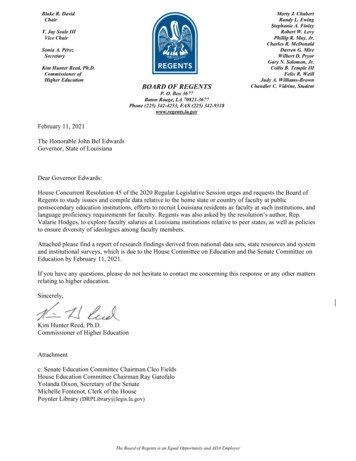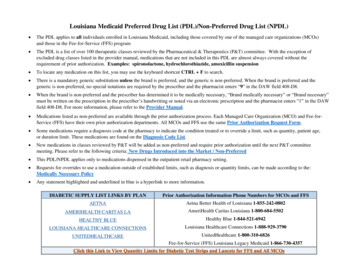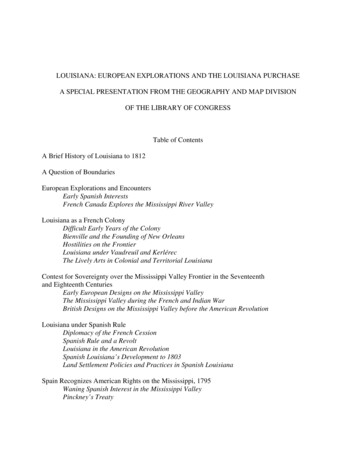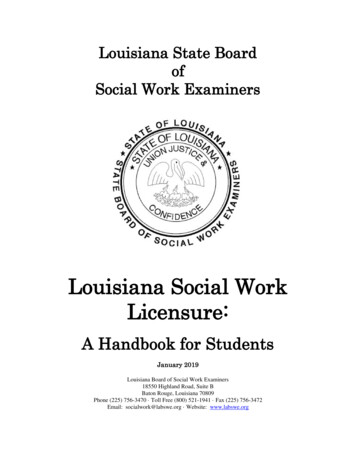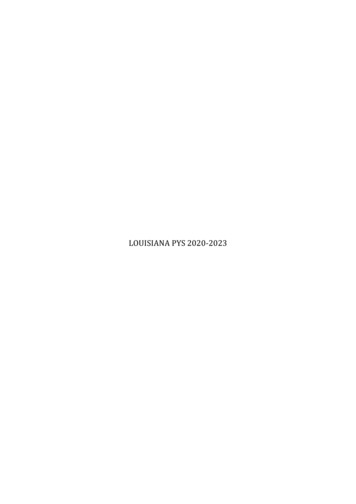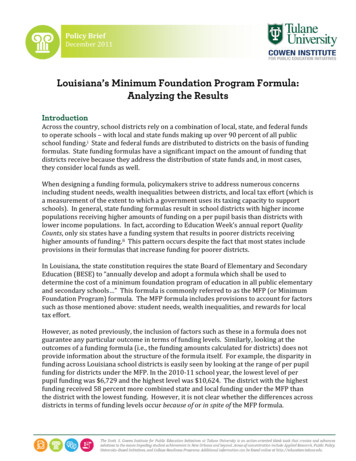
Transcription
Policy BriefDecember 2011Louisiana’s Minimum Foundation Program Formula:Analyzing the ResultsIntroductionAcross the country, school districts rely on a combination of local, state, and federal fundsto operate schools – with local and state funds making up over 90 percent of all publicschool funding.i State and federal funds are distributed to districts on the basis of fundingformulas. State funding formulas have a significant impact on the amount of funding thatdistricts receive because they address the distribution of state funds and, in most cases,they consider local funds as well.When designing a funding formula, policymakers strive to address numerous concernsincluding student needs, wealth inequalities between districts, and local tax effort (which isa measurement of the extent to which a government uses its taxing capacity to supportschools). In general, state funding formulas result in school districts with higher incomepopulations receiving higher amounts of funding on a per pupil basis than districts withlower income populations. In fact, according to Education Week’s annual report QualityCounts, only six states have a funding system that results in poorer districts receivinghigher amounts of funding.ii This pattern occurs despite the fact that most states includeprovisions in their formulas that increase funding for poorer districts.In Louisiana, the state constitution requires the state Board of Elementary and SecondaryEducation (BESE) to “annually develop and adopt a formula which shall be used todetermine the cost of a minimum foundation program of education in all public elementaryand secondary schools ” This formula is commonly referred to as the MFP (or MinimumFoundation Program) formula. The MFP formula includes provisions to account for factorssuch as those mentioned above: student needs, wealth inequalities, and rewards for localtax effort.However, as noted previously, the inclusion of factors such as these in a formula does notguarantee any particular outcome in terms of funding levels. Similarly, looking at theoutcomes of a funding formula (i.e., the funding amounts calculated for districts) does notprovide information about the structure of the formula itself. For example, the disparity infunding across Louisiana school districts is easily seen by looking at the range of per pupilfunding for districts under the MFP. In the 2010-11 school year, the lowest level of perpupil funding was 6,729 and the highest level was 10,624. The district with the highestfunding received 58 percent more combined state and local funding under the MFP thanthe district with the lowest funding. However, it is not clear whether the differences acrossdistricts in terms of funding levels occur because of or in spite of the MFP formula.
Thus, to truly understand the MFP formula, Louisiana’s approach to education fundingshould be evaluated not only based on the philosophy and intent behind its design, but alsoon its real world results in terms of how many funds reach students.This paper will examine the MFP formula from several perspectives. First, generalinformation on funding formulas will be presented. Next, the basic components andstructure of the MFP formula will be discussed. Then, the outcomes of the formula – that is,the funding levels determined by the formula – will be analyzed based on how well thegoals of the formula are achieved. In this section, total funding will be examined as well asthe funding generated by different parts of the formula. Lastly, two studies of state fundingformulas are reviewed to see how the MFP compares to other states’ formulas.Education Funding PoliciesMost funding for public education comes from local and state sources, but the distributionvaries by state. Nationally, the state share of education funding was 48 percent in 2008.Local sources accounted for a roughly equal amount of funding – 44 percent. Federalsources made up only eight percent of funding.iiiRevenue from both local and state taxes provides for the costs of operating schools,including teacher salaries, facilities maintenance, instructional materials, andextracurricular programming. To help ensure that all children have the opportunity toreceive a quality education, states have developed education funding policies about localand state funding.Funding FormulasAcross the nation, states take a variety of approaches to school funding. There are fivemain approaches states take in education funding formulas: foundation; equalization; local-effort equalization; flat grant; and full state funding.Most states implement two or more of these approaches in combination.By far, the most popular approach to school funding is a foundation formulaiv. In 38 states,districts are guaranteed a minimum foundation level amount per pupil or teacher unit.Each district is expected to contribute a specified proportion of this amount and the stateprovides additional funds to reach the guaranteed level. Most states with a foundationformula set a uniform per pupil foundation amount for all districts. Alternatively, sevenstates have a foundation amount per student that varies by district. Foundation formulasare generally used in combination with various methods of fairly equalizing funding levelsacross districts according to need and effort.Equalization approaches to school funding are designed to ensure that pupils in all districtshave the same opportunity to receive a quality education. General equalization measuresLouisiana’s Minimum Foundation Program: Analyzing the Results2
adjust state funding according to property wealth, taxation effort, and/or relative need.Local-effort equalization policies guarantee an equal yield for equal tax effort, regardless ofa district’s wealth. Flat grants and full-state formulas are the least common approach andprimarily rely on state revenue.Louisiana uses a minimum foundation formula along with equalization measures. The basefunding for each district was set at 3,855 per pupil using the weighted count (in the 201011 school year). The proportion of the total funding that is provided by the state versus thelocal district is based on district wealth (defined by the tax base). As discussed below,Louisiana also provides additional funding based on district characteristics and studentneeds.Weights and Categorical FundingMany state formulas recognize that particular types of students may require additionalresources by incorporating weights into their funding formulas. Across the country, statesrecognize a variety of different student weight categories including disability status,English-language learners (ELL), low income, grade level, and career and technical units.Some states use tiered weighting systems to account for varying severity of conditions. Forexample, the District of Columbia distinguishes between four levels of special educationstudents with weights ranging from 1.5 to 3.37. Although weighted formulas are meant toprovide districts with extra resources to meet the needs of specific students, most states,unlike Louisiana, do not place restrictions on how a district may spend additional fundsreceived from weighted studentsv. This means that these funds can be used for purposesother than providing services to the students who generated the extra funding in thosestates.Formulas can also be weighted to address certain district characteristics that influenceoverall cost. Common factors that justify district weights include district size, location,cost-of-living, teacher education or experience, and academic performance. As opposed tostudent weights that are applied to individual students, district weights are applied to allstudents enrolled in a district.In addition to weights, categorical funds often supplement funding formulas to addressparticular types of needs. Programs or expenditures that commonly receive categoricalfunding include programs for special education students, gifted and talented students,bilingual/ELL students; transportation; capital and debt service; technology; teacherbenefits; and compensatory education programs. Other states have implementedinnovative categorical grants such as nutrition programs, alcohol/drug abuse programs,and security-related activities.viLouisiana weights four categories of students: special education, gifted and talented, “atrisk” (defined as students who qualify for free or reduced priced lunch), and career andtechnical units. Louisiana also adjusts its formula to account for a lack of economies ofscale by providing additional funding to smaller districts.Louisiana’s Minimum Foundation Program: Analyzing the Results3
Louisiana’s Approach to School Funding: The Minimum FoundationProgramThe formula that the state of Louisiana uses to determine state and local funding forschools is called the Minimum Foundation Program (MFP) formula. In 1992, the stateBoard of Elementary and Secondary Education (BESE) undertook a complete overhaul ofthe formula used to fund districts, creating the MFP formula. This new formula aimed toincrease equalization in funding across districts with varying degrees of wealth.vii In 2006,BESE convened a task force to review certain components of the formula, such as theweights applied to different categories of students as well as the base funding amount.Other than small changes to the weights, however, the formula has remained unchangedsince it was put in place nearly 20 years ago.Context of Public Education in LouisianaWhen examining the MFP formula and its results, it is important to understand the largercontext of education in Louisiana. Louisiana has among the highest levels of studentpoverty in the country. Sixty-six percent (66 percent) of Louisiana students qualify for freeor reduced priced lunch (based on low household income) compared with a nationalaverage of 41 percent.viiiNumber of DistrictsFigure 1: Districts and StudentPoverty %above 90%Percent of Students in District Eligible forFree or Reduced Price LunchNot only do Louisiana’s public schoolshave one of the highest poverty rates inthe country, but the state also suffersfrom an extremely high concentration ofpoverty within its school districts. Themajority of students are enrolled indistricts in which between 50 percentand 90 percent of the student body iseligible for free or reduced priced lunch.Moreover, not a single district in thestate has less than 40 percent of itsstudents eligible for free and reducedlunch.ixStudents from low socioeconomic families tend to demonstrate significantly loweracademic performancex. Thus, as expected, the Assessment Indices for districts (calculatedbased on a district’s standardized test scores) decrease significantly as the percentage offree or reduced priced lunch (FRL) students increases. Evidence suggests additionally thatthe environment created by a school’s poverty concentration may also have an impact onstudents in addition to the effects of their own background.xi As a result, all students-regardless of socioeconomic status—tend to demonstrate lower academic performancewhen in a high-poverty school or district.As shown in Figure 2, the performance of FRL students decreases as the concentration ofpoverty in the district increases. (A trend line is included to help show the general patternin the distribution of districts in the scatterplot.) As the chart on the right shows, studentsLouisiana’s Minimum Foundation Program: Analyzing the Results4
who do not qualify for FRL exhibit the same decline in performance as the povertyconcentration increases. Some other states, such as Illinois, use a district weight based onpoverty concentration to provide additional funding for all students in impoverisheddistricts.Figure 2: Assessment Index (AI) for Students by Poverty ConcentrationStudents Not Eligible for Free orReduced Priced Lunch140140120120Assessment IndexAssessment IndexStudents Eligible for Free or ReducedPriced Lunch1008060402010080604020000.40.60.81Percentage of Students Eligible forFree or Reduced Price Lunch0.40.60.81Percentage of Students Eligible forFree or Reduced Price LunchDistrictSource: Louisiana Department of Education Public School Enrollment (2009), District Subgroup Assessment Index (20092010)In part, the higher concentration of low-income public school students in Louisiana schoolsis due to the fact that many students from higher income families attend private orparochial schools. Louisiana has the third lowest coverage rate (defined as the percentageof school-aged children who are enrolled in public schools) in the nation accompanied byone of the highest income gaps between private and public school families.xii Withoutsignificant changes to its education policy, these trends are likely to continue. Studentsfrom wealthy and middle-class backgrounds will continue to choose private education,leaving low-income students concentrated in poorly funded schools with few resources toprovide a quality academic environment.The Design of the MFPIn Louisiana, the MFP considers local and state revenue under a single formula to ensurethat every student in Louisiana receives at least a minimum foundation of education. TheMFP formula includes factors that provide additional funding for specific district needs,reward high tax effort, and cover the cost of certain teacher pay raises that were initiatedby the legislature.Louisiana’s Minimum Foundation Program: Analyzing the Results5
State funding in the MFP comes from an annual appropriation by the state legislature.Overall, the state contributes approximately 59 percent of total MFP funds1. The shareprovided by individual districts, however, varies based on the wealth of individual districttax bases, with wealthier districts receiving a lower percentage of state funding thanpoorer districts. In the 2010-11 school year, the local share of funding under the MFPformula ranged from 16-68 percent.As discussed previously, Louisiana’s MFP formula takes many elements into considerationwhen determining appropriate levels of and distribution of funding. Student needs: The MFP formula provides districts with additional funding toeducate particular types of students. The state recognizes special education,gifted and talented, “at-risk” (or low-income students), and career andtechnical units as requiring extra funds. District characteristics: The MFP adjusts for particular district characteristicsincluding membership size (or, weighted enrollment) and tax base. The stateoffers additional funding to address lack of economies of scale for districtswith less than 7,500 students. Additionally, the formula expects wealthierdistricts to contribute more to their funding levels than poorer districts. TheMFP formula defines a district’s wealth as the sum of total assessed propertyvalue and sales tax base. Other: The MFP also incorporates hold harmless policies (to protect revenuesfor districts that received more funding under the prior formula) and stateapproved teacher pay raises for particular districts.Three Tiers of FundingThe MFP formula determines funding for districts using three different “levels”, each withits own formula. The funding amounts determined under each level are combined tocalculate the total combined state and local funding for each district.Level 1: Under Level 1, each district is guaranteed 3,855 (in 2010-11) per weightedenrolled student. To determine how much of this amount will be funded by the localdistrict and how much will be funded by the state, the state determines a standardtax rate and expects each district to contribute the amount of money calculated byapplying the rate to the district’s tax base. (This standard tax rate is the same forevery district.) The state then provides each district with additional funds to meetits guaranteed amount of 3,855 per weighted enrolled student. Because wealthierdistricts generate high levels of local revenue under the expected tax rate, theyreceive a relatively smaller share of their Level 1 funds from the state.Level 2: Level 2 is designed to provide incentives for local tax effort. If districtsexceed their Level 1 expected contribution, the state rewards their effort by1As discussed in the next section, the MFP formula has three different components. The proportion of statefunding varies for each part of the formula. When all three levels of the MFP are considered, the state sharecombined state and local funding is 59 percent.Louisiana’s Minimum Foundation Program: Analyzing the Results6
matching a portion of the extra revenue. Revenue eligible for Level 2 matching iscapped at 34 percent of a district’s total Level 1 costs.Level 3: Level 3 includes a continuation of legislatively-mandated pay raises fromprevious years, hold harmless funding (for districts that received more fundingunder the prior formula), and funding for foreign language associates/teachers.Figure 3: Districts with Highest and Lowest State andLocal Funding under the MFP FormulaPer Pupil Funding 12,000 10,000LEVEL 3 8,000LEVEL 2 6,000LEVEL 1 4,000 2,000 0Figure 3 shows the five districts with the lowest combined state and local funding underthe MFP and the five districts with the highest total funding under the formula in the 201011 school year. The amount of funding generated by each level of the formula is shown foreach district. As the chart shows, the districts that receive the highest overall fundingreceive more funding from each level on average. The greatest disparity between the twogroups occurs in the amount of funding generated under Level 2, which rewards local taxeffort.The table below provides information about funding for all districts. It shows the meanfunding under the MFP program and the range from lowest to highest total funding perpupil.Per-Pupil State and Local Funding under the MFP FormulaMeanRangeStandard Deviation 8,763 6,729 - 10,624 743Louisiana’s Minimum Foundation Program: Analyzing the Results7
Evaluating Outcomes of the MFPThe MFP formula is a complex one that includes a variety of factors and considerations.Because of the complexity of the formula, it is important to examine how the differentcomponents work together. The following section examines the outcomes of the MFPformula for the 2010-11 school year by looking at funding under the formula.The specific outcomes that are examined are the levels of funding for different districts ascompared to key characteristics of each district. Three of the main district characteristicsincorporated into the MFP formula are the needs of students in each district, the wealth ofthe tax base of each district, and the tax revenue collected by each district. This sectionfirst looks at the relationship between each of these factors and the total level fundingunder the MFP for every district. Next, the individual levels of funding in the MFP formula(Levels 1, 2, and 3) are examined along the same lines.In order to evaluate the MFP, this paper establishes two measures to characterize districts.Needs Ratio: Students with special needs are counted as greater than one studentwhen calculating total enrollment under the MFP. The value of each category’s weightis based on expected additional costs of educating a particular type of student.Louisiana uses four categories of student weights: “at-risk” (defined as qualifying forfree or reduced priced lunch), special education, gifted and talented, and career andtechnical units. “At-risk” are considered 1.22 students; special education students arecalculated as 2.5 students; gifted and talented students are calculated as 1.6 students;and career and technical units are calculated as 1.06 students.This paper uses a “needs ratio” to indicate the aggregate special needs characteristics ofa district’s student population. It is calculated as a ratio of weighted enrollment toactual (unweighted) enrollment. Higher values indicate student populations withgreater needs.District Wealth Indicator: The “wealth indicator” is calculated by summing a district’stotal assessed property value and sales tax revenue and dividing by its number of publicschool students.2 This measure reflects a district’s ability to raise revenue, not theincome levels of its residents or socio-economic status of its students.Total FundingThe MFP recognizes that there are higher costs to providing an education to certainstudents by weighting particular categories of students more in the formula. It is expectedthat this would result in higher funding for districts with more students with special needs2For the purposes of creating the district wealth indicator, the actual property and sales tax bases presentedin the MFP spreadsheet was used. For districts that experience a property or sales tax base increase of 10 or15 percent (respectively), the MFP formula gradually incorporates the tax base increase. However, for theanalyses in this paper, the actual tax base is a better measure of district wealth.Louisiana’s Minimum Foundation Program: Analyzing the Results8
recognized by the formula. As Figure 4 demonstrates, total funding is correlated with theneeds ratio. That is, generallyFigure 4: State and Local Funding under thespeaking, the districts with the highestMFP Formula by District Needs Rationeeds ratios also receive the highesttotal funding under the MFP.1.901.80Needs RatioAnother factor that the MFP considersis the wealth of each district. In Level1 of the formula, a district’s expectedlocal contribution is based on the taxbase of the district. Figure 5 shows therelationship between combined stateand local funding under the MFPformula and the wealth indicator ofeach district in Louisiana. As the chartdemonstrates, total funding iscorrelated with the wealth of adistrict’s tax base.1.701.601.501.401.301.20 6,000 7,000 8,000 9,000 10,000State and Local Funding Per Pupil 11,000Wealth IndicatorIn addition to the tax base of a district,the MFP formula also accounts for the tax revenues of each district. Tax revenue isdetermined by the both the tax base and the tax rate in any district. Actual revenueinfluences the total funding of aFigure 5: State and Local Funding under thedistrict under the MFP. Taxrevenue that a district raises inMFP by District Wealth Indicatorexcess of the minimum amount 500,000that it is expected to contribute 450,000to Level 1 is carried forward in 400,000the formula and is used todetermine state funding in Level 350,0002 of the formula. 300,000 250,000Figure 6 shows the relationship 200,000between combined state and 150,000local funding under the MFP 100,000formula and local tax revenue 50,000per pupil. As the chart shows,local effort is correlated with 0 6,000 7,000 8,000 9,000 10,000 11,000total funding under the MFPStateandLocalFunding Per Pupilprogram. Generally speaking,those districts that raise more local money per pupil receive higher overall funding.Louisiana’s Minimum Foundation Program: Analyzing the Results9
Figure 6: State and Local Funding under the MFPby Local Revenue Per PupilLocal Revenue Per Pupil 12,000 10,000 8,000 6,000 4,000 2,000 0 6,000 7,000 8,000 9,000 10,000State and Local Funding Per Pupil 11,000Level 1Level 1 of the MFP formula establishes a base level of funding for every public schoolstudent in Louisiana using a weighted student count for each school district. After the totalfoundation level is determined, the next step in Level 1 of the formula is to calculate theportion of the total Level 1 funding that the state will contribute.Once districts receive theirLevel 2 and 3 funds, fundingper pupil is less stronglycorrelated with a district’sLevel 1 Funding Per PupilLevel 1 guarantees districts a constant amount of funding per weighted student, regardlessof local tax effort. Weighted enrollment is based solely on the district’s number of enrolledstudents and their needs. For example, in the 2010-11 school year a district with 1,000enrolled students and aweighted enrollment ofFigure 7: Level 1 Funding per Pupil by Needs1,200 students, would haveRatioa minimum foundation 7,500amount of 1,200 * 3,855 7,000 4,626,000. As expected,therefore, Level 1 funding is 6,500directly correlated with the 6,000needs ratio. Therelationship between Level 5,5001 funding and the Needs 5,000Ratio is shown in Figure 7. 4,500 4,0001.201.401.60Needs RatioLouisiana’s Minimum Foundation Program: Analyzing the Results1.8010
needs ratio. Comparing Figure 7, which shows Level 1 funding, with Figure 4, which showstotal funding under the MFP, highlights that a district’s total funding is determined byseveral factors in addition to its students’ needs.Figure 8: State Share of Level 1 byDistrict Wealth Indicator100%90%State Share of Level 1The state provides a varyingpercentage of the minimumfoundation amount to eachdistrict based on its ability toraise funds. As shown inFigure 8, the state share ofLevel 1 is highly correlatedwith district wealth. Poorerdistricts with fewer taxableresources receive higherlevels of funding from thestate. In contrast, wealthierdistricts are expected to funda much larger share of theirfoundation costs.80%70%60%50%40%30%20%10%0% 0 100,000 200,000 300,000 400,000 500,000Level 2District Wealth IndicatorLevel 2 is designed to rewardlocal tax effort, regardless ofdistrict needs. The state provides additional funding to districts based on how muchrevenue each district raises locally. Specifically, the state portion of Level 2 funding isbased on the “local revenue over Level 1,” which is the amount of revenue that a localdistrict raises that is above the amount the district is required to contribute to Level 1. Forexample, according to the 2010-11 MFP calculations, the St. Martin Parish School Boardraised approximately 19 million in total revenues. The district was expected to contributeabout 9 million to Level 1, so the district’s local revenue over Level 1 was 10 million. Thestate matches only a portion of a district’s local revenue over Level 1.3 On average, in the2010-11 school year the state provided each district with an extra 680 per pupil (i.e., thestate share of Level 2). Some districts received no extra funding; the highest state share ofLevel 2 funding was 1,349 per pupil.Two examples help illustrate how district wealth and local revenue over Level 1 can impactLevel 2 funding:3 The MFP formula sets a cap on the amount of revenue that is eligible for match. The cap is equal to thelower of (1) a district’s local revenue over Level 1 or (2) 34 percent of the total Level 1 cost for the district.Once the revenue that is eligible for match is determined, the next step in the formula is to determine thelocal share of Level 2. The local share of Level 2 is equal to [the local share of Level 1 as a percentage] X 1.72X the revenue that is eligible for match. The state share of Level 2 is the difference between the cap and thelocal share. If the local share is more than the cap, then the state contributes no money to Level 2 for thatdistrict.Louisiana’s Minimum Foundation Program: Analyzing the Results11
Districts with comparable taxing abilities: When variations in Level 2 funding existbetween districts with comparable ability to raise revenue, this likely indicates adifference in tax effort in the two districts. For example, West Carroll and Caldwelldistricts have almost equal measures of wealth and poverty (as defined by the MFPformula). Both districts are expected to contribute roughly 16% to their Level 1costs. Caldwell demonstrates much higher tax effort, however, by bringing in overtwice as much revenue per pupil above its Level 1 share as West Carroll does. As aresult, Caldwell receives over twice as much Level 2 funding per pupil from the state( 1,349) as West Carroll does ( 563).Districts with differing taxing abilities: For example, Pointe Coupee and Winn parishschool boards both raise about 1,400 per pupil above their required Level 1 shares.Pointe Coupee’s high wealth indicator, however, indicates that it was able to raisethis amount by exerting less effort than Winn Parish. Districts with large tax basesare expected to raise more revenue than poorer districts with fewer taxableresources. Because of its low demonstrated effort, Pointe Coupee receives only 223 per pupil in Level 2 funding from the state while Winn receives 938 per pupil.Although a district’s taxing effort has an impact on Level 2 funding, the wealth of a districtis also correlated with Level 2 funding. The three graphs below show the relationshipbetween Level 2 funding and district wealth as measured by the district wealth indicator. Figure 9 shows the relationship between the local share of Level 2 funding anddistrict wealth. The general pattern is that districts with higher wealth contributemore local money for Level 2. This is to be expected because a district’s local shareof Level 2 funding is based in part on that district’s local share of Level 1 funding asa percentage. Because wealthier districts are expected to contribute a higherpercentage to their Level 1 funding, it follows that their contributions to Level 2funding would also be higher.Figure 10 shows the relationship between the state share of Level 2 funding anddistrict wealth. In this case, the trend is reversed: districts with lower wealthindicators received more Level 2 funding from the state than districts with higherwealth indicators. Again, this is to be expected given that the state share of Level 2is the difference between total eligible revenue (for Level 2) and the local share ofLevel 2 funding.Figure 11 shows the relationship between total Level 2 funding and district wealth.Here, the association is more complicated. The districts with the highest wealthindicators (approximately 200,000 per pupil and higher) tend to cluster in themiddle of the distribution in terms of total Level 2 funding, close to 2,000 perstudent. These are the same districts that receive relatively little or no funding
The formula that the state of Louisiana uses to determine state and local funding for schools is called the Minimum Foundation Program (MFP) formula. In 1992, the state Board of Elementary and Secondary Education (BESE) undertook a complete overhaul of the formula used to fund districts, creating the MFP formula. This new formula aimed to
